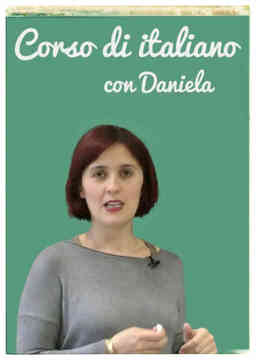









Difficulty:
 Beginner
Beginner
Italy
Are you ready for plenty of expressions using the verb vedere (to see)? Andiamo a vedere (let's go see)!
Difficulty:
 Intermediate
Intermediate
Italy
Here are some more expressions featuring the verb vedere (to see). For non-native speakers, a few of them might be a little tricky to understand, but others might be very useful to learn and use.
Difficulty:
 Newbie
Newbie
Italy
Let's learn some numbers and colors in Italian.
Difficulty:
 Beginner
Beginner
Italy
As promised, Marika talks about the verb tenere (to keep, to hold), beginning with its conjugation. Let's keep in mind that Italian tenses don't always correspond to the English ones. For example, the passato prossimo is conjugated like the English present perfect tense, but is used differently in expressing events in time. The imperfetto is translated various ways in English. See this lesson about the imperfetto.
Difficulty:
 Beginner
Beginner
Italy
We learn in this segment that the verb tenere can mean not only "to hold," but also "to keep" or "to have."
Difficulty:
 Beginner
Beginner
Italy
Here's the last segment about the verb tenere where Marika provides several expressions using the verb. In some cases, we can use "to keep" and "to hold" when translating, but not always.
Difficulty:
 Beginner
Beginner
Italy
Marika describes some situations, asks a related question, and provides us with various ways to answer in the affirmative. 18 ways to say sì (yes).
Difficulty:
 Beginner
Beginner
Italy
Just as there are many ways of saying "Yes" without saying sì, there are plenty of ways of saying "No" without saying no. Check them all out!
Difficulty:
 Beginner
Beginner
Italy
Marika has set up a Q & A series of videos specifically designed to answer your questions in more detail and with more examples than what is possible in the comments section of a Yabla video. She explains how it works in this video, so don't miss out on the opportunity to get your questions answered!
Difficulty:
 Beginner
Beginner
Italy
There are a great many expressions with la testa (the head) as the protagonist. Marika, gives us a first round of explanations and examples, many of them from Yabla videos.
Difficulty:
 Beginner
Beginner
Italy
Marika's explanations together with examples from video clips make it easy and fun to learn new expressions using la testa (the head).
Difficulty:
 Beginner
Beginner
Italy
There are various ways to talk about being obsessed, distracted, or crazy... Marika has some great examples from our favorite TV series.
Difficulty:
 Intermediate
Intermediate
Italy
Marika provides more useful expressions involving the head, many of which are also common in English.
Difficulty:
 Beginner
Beginner
Italy
Italians scratch their heads when they are perplexed, just like English speakers do. It's grattarsi la testa. In this segment, Marika explains this and other expressions having to do with the head. Sometimes "testa" can be translated as "head" and other times, as "mind."
Difficulty:
 Beginner
Beginner
Italy
In this last part, Marika provides some expressions to use when you're frustrated or when you forget what you were about to say. They all use la testa (the head) as the featured body part.
Difficulty:
 Beginner
Beginner
Italy
When you have plenty of confidence or trust someone, you might keep your eyes closed and do something "ad occhi chiusi" (with your eyes closed), but make sure to keep them open while watching this video about expressions featureing l'occhio (the eye).
Difficulty:
 Beginner
Beginner
Italy
Marika gives us plenty of examples of expressions using l'occhio (the eye) in this final segment. We see and hear them in context by way of clips from Yabla videos.
Difficulty:
 Beginner
Beginner
Italy
Navigating the adjectives or pronouns che (what), cosa (what), and quale (what, which) is confusing to most learners, but Marika helps us make sense of it all.
Difficulty:
 Beginner
Beginner
Italy
After saying Pronto? (hello), what do you say when calling someone, or when someone calls you? Marika has all the answers.
Difficulty:
 Beginner
Beginner
Italy
Marika explains a one-word expression that many learners are curious about: figurarsi. It basically means "to imagine," but it has many nuances depending on the context.
Difficulty:
 Beginner
Beginner
Italy
Marika shares with us some very useful expressions using il naso (the nose) and the sense of smell, called l'olfatto in Italian.
Difficulty:
 Beginner
Beginner
Italy
You will find out in this video that there are really a lot of expressions using la lingua (the tongue). The tongue can be lunga (long), sciolta (loose), biforcuta (forked) and more. We use the tongue when we speak, so lots of these expressions involve speaking.
Difficulty:
 Beginner
Beginner
Italy
There are quite a few expressions having to do with the ear and Marika gives us plenty of examples. Let's keep in mind that the plural of orecchio is orecchie, in other words, a masculine singular noun with a feminine plural. But in some places, people use the masculine plural orecchi.
Difficulty:
 Beginner
Beginner
Italy
There are a lot of Italian expressions using la bocca (the mouth) in a literal or figurative way. Marika tells us about some of them
Are you sure you want to delete this comment? You will not be able to recover it.